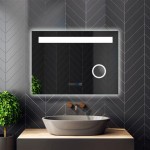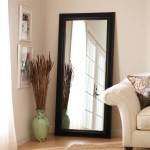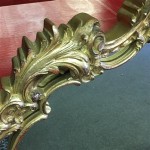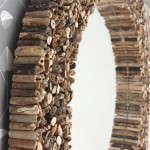Framing a Bathroom Mirror DIY: A Step-by-Step Guide
A bathroom mirror is an essential element, serving both functional and aesthetic purposes. But a plain, unadorned mirror can feel somewhat lackluster. Framing your bathroom mirror, however, can instantly elevate its appearance, adding a touch of personality and style to your space. This DIY project allows you to personalize your bathroom decor, transforming a simple mirror into a focal point. This guide provides a comprehensive step-by-step approach to framing a bathroom mirror, empowering you to create a stunning and unique addition to your bathroom.
Choosing the Right Frame Material
The first step in framing your bathroom mirror is selecting the right frame material. The choice depends primarily on your personal preferences and the overall style of your bathroom. Here are some popular options:
- Wood: A classic and versatile choice, wood offers a wide range of colors, finishes, and styles. From rustic reclaimed wood to sleek modern laminate, wood frames can complement any bathroom aesthetic.
- Metal: Metal frames provide a contemporary and industrial feel. Options include stainless steel, brass, copper, and iron, each offering a distinct aesthetic.
- Plastic: Plastic frames are a budget-friendly and lightweight option. They come in various colors and designs, making them suitable for both modern and traditional bathroom styles.
- Moulding: Moulding strips, often found in wood or PVC, are an excellent choice for creating a more intricate and detailed frame. This option allows for greater customization and the creation of unique designs.
Consider the size of your mirror, the overall style of your bathroom, and your budget when selecting the frame material. You can even use materials you already have on hand, such as salvaged wood or leftover tile, to create a one-of-a-kind frame.
Preparing the Frame and Mirror
Once you've chosen your frame material, it's time to prepare it and the mirror for assembly. The following steps ensure a smooth and successful framing project:
- Measure the Mirror: Accurately measure the length and width of your mirror to ensure the frame fits perfectly. You can use a tape measure or ruler for this step.
- Cut the Frame: Cut the frame material according to the mirror's dimensions, ensuring the frame is slightly larger than the mirror to allow for a small border. If you're using wood or moulding, use a saw to make precise cuts. For metal or plastic, you might need a cutting tool specific to the material.
- Sand the Frame: If using wood, sand the frame to smooth any rough edges and provide a better surface for paint or stain. Use sandpaper with progressively finer grits to achieve a smooth finish.
- Clean the Mirror: Clean the mirror surface thoroughly with a glass cleaner and microfiber cloth to remove any dust or residue that may interfere with the adhesive.
Take your time with these preparation steps, ensuring that the frame and mirror are ready for assembly. Accuracy and cleanliness are crucial for a professional and lasting result.
Assembling the Mirror Frame
Finally, it's time to assemble the mirror frame. The assembly process depends on the type of frame material you've chosen. Here's a general guide for common materials:
Wood Frames
- Glue and Nail: Apply wood glue to the frame's mating edges and attach them using finishing nails. Be sure to use a nail gun or hammer with a nail set to avoid damaging the wood's surface.
- Miter Joints: For a more refined finish, use a miter saw to cut the frame pieces at 45-degree angles. This creates precise miter joints that fit together seamlessly.
- Clamps: Secure the frame corners with clamps until the glue dries completely. This ensures a strong and secure bond.
- Finishing Touches: Sand the frame edges after the glue has dried, removing any glue residue or roughness. Apply paint or stain to match your bathroom's decor.
Metal Frames
- Corner Connectors: Use metal corner connectors to join the frame pieces securely. These connectors come in various styles and finishes, allowing you to customize the frame's appearance.
- Screws: Attach the connectors to the frame using screws. Ensure the screws are long enough to secure the connectors without poking through the frame.
- Finishing: Once the frame is assembled, you can paint or finish the metal according to your preference. Metal paints and finishes can provide a wide range of looks.
Plastic Frames
- Snapping or Clicking: Most plastic frames utilize snap-on or click-together mechanisms for assembly. Follow the manufacturer's instructions for assembling the frame.
- Adhesive: If the frame doesn't have a snap-on mechanism, you can use a strong adhesive to attach the frame pieces. Apply adhesive to the mating edges and press them together firmly.
- Finishing: Plastic frames are often sold with a finish or can be easily painted to match your bathroom decor.
After assembling the frame, allow it to dry completely before proceeding to the next step. When the frame is fully cured, you can proceed to attaching it to the mirror.

Mirror Frame Diy How To Update A Basic Bathroom Our Faux Farmhouse

Diy Framed Bathroom Mirrors Living With Lady

Diy Bathroom Mirror Frame For Under 10 O Hayley Blog

Diy Stick On Mirror Frame Sawdust Sisters

Mirror Frame Diy How To Update A Basic Bathroom Our Faux Farmhouse

Diy Bathroom Mirror Frame Without Removing Clips Her Happy Home

Diy Bathroom Mirror Frame With Molding The Happier Homemaker

How To Make An Easy Diy Bathroom Mirror Frame Momhomeguide Com

How To Make A Diy Bathroom Mirror Frame Thediyplan
Diy Wood Frame Mirror Farmhouse Industrial Bathroom Joyfully Treasured








